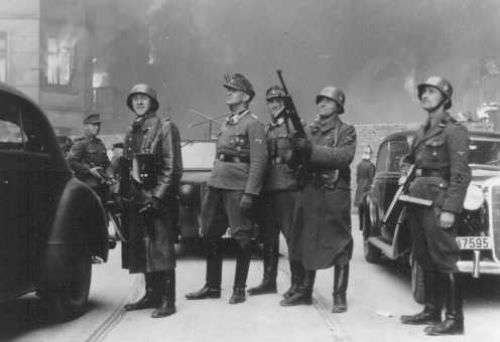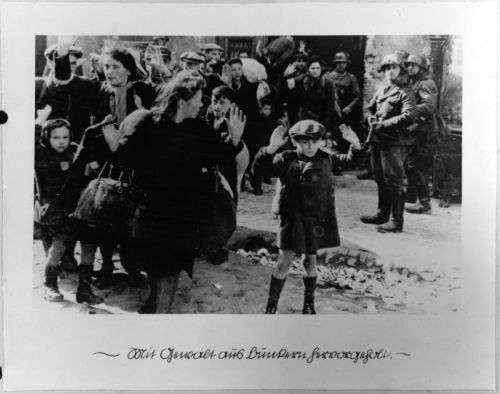Josef Blösche

Joseph Blösche, far right, with Jurgen Stroop during the Warsaw Ghetto Uprising 1943 (from the Stroop Report)
Joseph Blösche was born on February 12, 1912, in Friedland, then part of the Austro-Hungaria empire, today it is part of the Czech Republic. He left school early and worked as a waiter in his parents inn, the 'Gasthof zum Tongrund,' in Friedland, which was located close to the border with Poland. Joseph Blösche joined the Sudetendeutsche Partei and during 1938, joined the Nazi Party, after the Germans took control of the Sudetenland, and he became a member of the SS.
Following the German invasion of Poland in September 1939, Joseph Blösche was posted to Warsaw and shortly afterwards took up duties in Platerow, which was then close to the border with the Soviets. He carried out patrols along the banks of the River Bug. During May 1941, he was transferred to the Gestapo office in Siedlce. With the German attack on the Soviet Union in June 1941, Joseph Blösche was sent to the area of Baranowitschi, where he served in an Einsatzgruppen unit (mobile killing squad), where he took part in shooting 'aktions' against Jews.
In the autumn of 1941, Joseph Blösche was again transferred, this time to the Warsaw ghetto, and as a member of the Security Police he is engaged on guard duty in the ghetto. He becomes well-known in the ghetto, as he is responsible for many deaths. He specialises in shooting children engaged in smuggling, and he becomes known as 'Frankenstein' and is cited in a number of accounts about life in the ghetto.
Joseph Blösche cemented his place in history during the uprising in the Warsaw ghetto during April / May 1943, where he is photographed in a picture that has become the epitome of Nazi brutality against the Jewish race. For his zeal and effectiveness Joseph Blösche was awarded the Cross of War Merit 2nd Class with Swords when his service in Warsaw came to an end.

Joseph Blösche, second from right, pointing his machine gun at a young boy (from the Stroop Report)
After his arrest Joseph Blösche provided a handwritten statement on the reverse of a copy of this photograph on 12 January 1967:
The person appearing in the photocopy at hand, wearing an SS uniform, with a sub-machine gun in firing position and with motorcycle goggles over his steel helmet is me. The picture shows me, as a member of the Gestapo in the Warsaw ghetto, with a group of SS members during a deportation action.
Signed: Joseph Blösche - Berlin, 12 January 1967
In the second part of this article, the identity of the boy in the photo will be covered.
Joseph Blösche was still serving in the Gestapo office in Warsaw, and he fought in the August 1944, Uprising, and he is surrounded and cut-off by determined Polish resistance fighters, until rescued by German army forces after several days fierce fighting. When the revolt is finally crushed by the Nazis, he is posted to Skierniewice, and to Levoca, which is in Slovakia.
With the collapse of Nazi Germany in May 1945, Joseph Blösche fled to Vienna, Austria, and is taken prisoner by the Red Army. He worked in quarries and road construction and in 1946, he is moved from Russian custody to Czech custody, when he was transported to an internment camp in Vitkovice. He worked in the Coal Mine 'Louis' as a lorry driver. Two days after starting work there he did not notice a descending hoist cage, and was struck on the head. He was admitted to the hospital in Ostrava, with severe head injuries.
Joseph Blösche suffered a fractured skull and his jawbone and nose were disfigured, and these help him from being identified as the man responsible for war crimes. He left Ostrava in the summer of 1947, he escaped into the divided Germany known as West Germany, before crossing the border near Sonneberg, into the Russian occupation zone. He settled in the small village of Urbach, where his parents have settled after leaving the Sudetenland.
In Urbach, Joseph Blösche, married and raised two children and he secured employment in the Kaliwerk company. However, in the autumn of 1966, during a war crimes trial in Hamburg, that Joseph Blösche, has been identified and found living in the German Democratic Republic. On January 11, 1967, Joseph Blösche was arrested after having completed the night shift at the Kalibergwerk, Volkenroda and taken into custody, and charged with war crimes against humanity.
The trial against Joseph Blösche commenced in the District Court of Erfurt in April 1969, and on April 30, 1969, Blösche was sentenced to death for crimes against humanity. The sentence was carried out in Leipzig prison on July 29, 1969, where he was executed by a bullet to the back of the head. The body is cremated at Leipzig's South Cemetery and the ashes were buried at the same site.
The Boy in the Photo
Various claims have been made about the identity of this iconic photograph from the Warsaw Ghetto uprising during April / May 1943. The little boy with his hands raised has become famous through out the world, as a symbol of the Holocaust. Thanks to the research and book written by Richard Raskin, 'A Child At Gunpoint,' published in 2004, the possible identity may have been discovered.
Levi Zeillinwarger
In late 1999, the Ghetto Fighters' House in Israel was contacted by Avraham Zeilinwarger, then 95 years old. He informed the GFH Museum that the boy in the photograph was his son Levi, born in 1932. Avraham suggested the photograph was taken in the Warsaw Ghetto on Kupiecka Street, near Nalewki Street. Avraham, a ladies' hairdresser by profession had escaped during 1940, to Russia, whilst employed on forced labour.
Avraham also confirmed that the woman nearest to the boy, was in fact the boy's mother, whose name was Chana Zeilinwarger, and that he believed his wife Chana, his son Levi and his 9-year old daughter, all perished in a Nazi concentration camp in 1943.
Dr. Tsvi Nussbaum
In 1982, Dr Tsvi Nussbaum, a 47 -year old ear, nose and throat specialist in Rockland County, New York, USA, came forward stating that in 1943, he had been arrested in Warsaw, and that he might be the boy in the photograph. Tsvi claimed that whilst he had been arrested in Warsaw, he had never set foot in the ghetto. He was one of the Hotel Polsky 'Exchange Jews,' who were transferred from Warsaw to the Bergen-Belsen Concentration Camp, where they were incarcerated prior to being exchanged with German nationals held by the Allies.
Richard Raskin sought professional advice comparing Tsvi Nussbaum's 1945 passport photograph with the 1943 iconic image, and Dr Karen Ramey Burns, a forensic anthropologist at the University of Georgia came to the conclusion that although the mouth, nose and cheeks were consistent, there was one fundamental flaw:
'The ear lobes of the 1943 boy appear to be attached, whereas the ear lobes of the 1945 boy are not attached. This genetic trait cannot change with age and the difference indicates the pictures are not of the same boy.'
Artur Dab Siemiatek
Another claim was made in 1977 by Jadwiga Piesecka that the boy was named Artur Siemiatek, born in Lowicz in 1935. He was the son of Leon Siemiatek and Sara Dab, and the grandson of the signatory's brother Josef Dab. A similar claim was made the following year in Paris, by Jadwiga's husband Henryk Piasecki dated December 28, 1978.
Sources
Heribert Schwan - ARD/WDR German Television - The SS -Man Josef Bloesche - the life and death of a killer, 2003
Richard Raskin, A Child At Gunpoint, Aarhus University Press, Denmark 2004
Abraham Lewin - A Cup of Tears – A Diary of the Warsaw Ghetto
Thanks to the late John Ulrich Poulsen, Copenhagen, Denmark
Photographs - USHMM, Washington DC, USA.
© Holocaust Historical Society 2018

